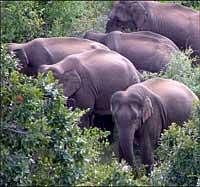
The epidemic has already killed six elephants and at risk are ungulates (hoofed animals) such as the gaur (wild bison), deer and domesticated animals such as cattle, sheep, pigs and goats. The forest department, as a preventive measure, will take up immunisation of the cattle in the region.
For the Asian elephant, whose numbers are already falling to the increasing man-animal conflict, the outbreak of HS in Biligiri Rangana Temple Wildlife Sanctuary (BRTWLS) and Satyamangala poses a mortal risk. The crisis had its origins in Bailur in BRTWLS adjacent to Sathyamangala forests, where three elephants have died since past 15 days.
“An elephant died a week ago, and two others died over the last five days. There have been three elephant deaths even on the other side of the border in Tamil Nadu. The problem is quite serious now,” said B K Singh, principal chief conservator of forests and chief wildlife warden.
Symptoms
Terming the outbreak alarming, Singh said this was sure to have infected other animals. However, he said, it will be difficult to track them in the 100-sq km range of Bailur.
“The death happens between three hours and 36 hours, and we will not even be aware about it till we find the carcass. We are now investigating more elephants infected with the disease,” Singh, who will be visiting the region on Tuesday, said.
Forest officers, who suspect cattle that enter the sanctuary from the adjoining village are the carriers, will immunise the bovines in the village. The surrounding villages have at least a lakh head of cattle.
Dullness, reluctance to move, and high temperature are the first signs of the disease. Then salivation and nasal discharge appear, and edematous swellings are seen in the throat which spread to rest of the body. Visible mucous membranes are congested, and respiratory distress is soon followed by collapse and death. Recovery is rare.
Dr Renuka Prasad, Director, Institute of Animal Health and Veterinary Biologicals, said the disease, which spreads through saliva discharge, can take either of the two forms - pneumonia and intestinal. Unvaccinated animals can die due to peracute and acute chronic disease within a week.“Since these are wild animals and unvaccinated, the risk of infection and death is greater,” he said.